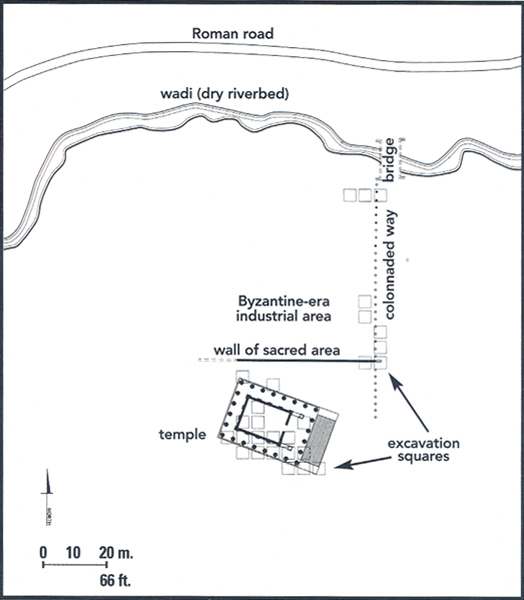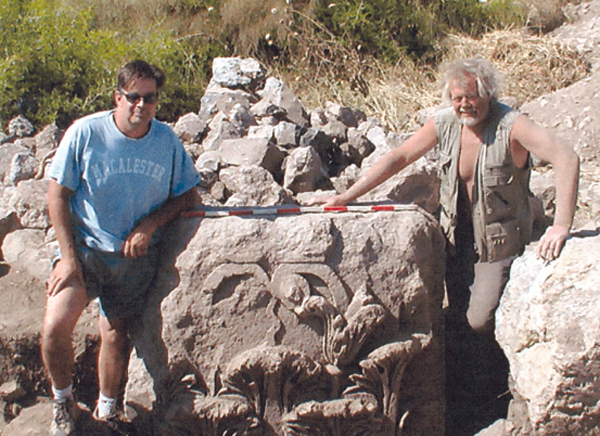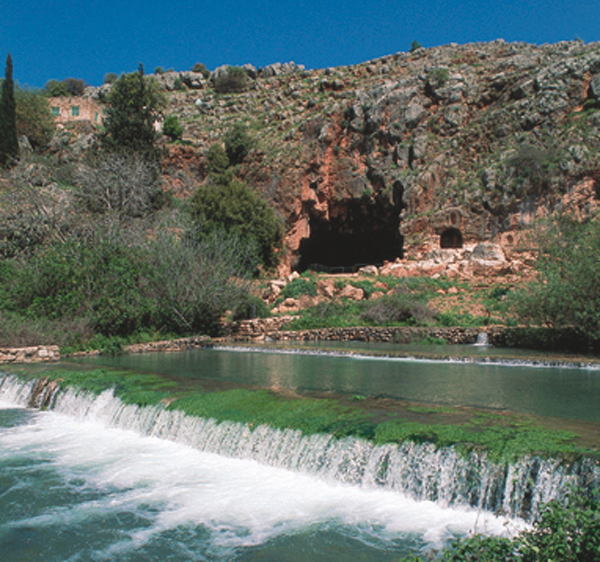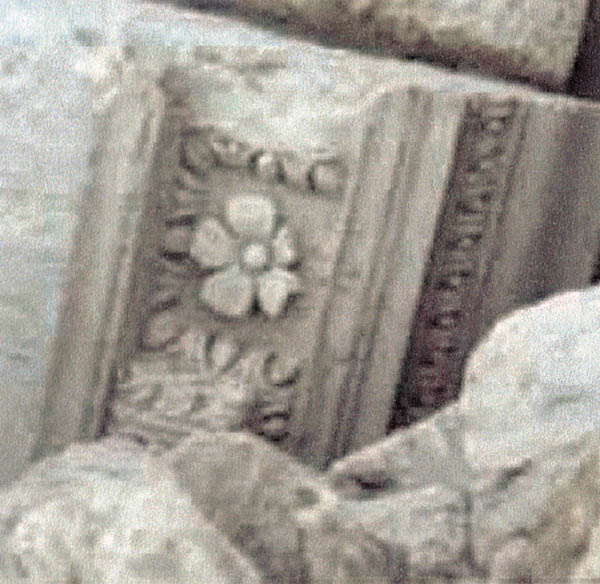
There is something here I think you ought to see,” our good friend Moti Aviam told us over the phone. It was the summer of 1998 and Aviam, then in charge of western Galilee for the Israel Antiquities Authority, was touring the devastation from a wildfire in drought-ridden northeastern Galilee, not far from the old border with Syria. Our team from Macalester College was just concluding a six-year project in Ukraine, excavating a synagogue on the Crimean peninsula,a so Aviam’s call came at an auspicious time for us. We went to survey the burned-out site, which is still called by its ancient name—Omrit.
Omrit rests on the southwest foothills of Mt. Hermon, in what is often referred to as “the finger of the Galilee.” It is located in the extreme north of Israel, near the Lebanese border, east of the modern city of Kiryat Shemona. This area has been the site of numerous battles—Israel’s War of Independence in 1948, the Six-Day War in 1967 and the 1973 Yom Kippur War. The region saw some of the fiercest tank battles of the 1967 and 1973 wars. In 1948 and 1967 the tell (mound) of Omrit served as a Syrian bunker.

In antiquity, however, Omrit stood prominently on the Roman road north from Beth-Shean and Tiberias, along the eastern edge of the Hulah Valley. At Omrit the road turns east and heads up the slopes of Mt. Hermon toward Damascus, near the major west-east highway from Tyre.
Omrit appears to have marked the beginning of the area known in the late Hellenistic and Roman periods (150 B.C.E.-150 C.E.) as Iturea. The Itureans made their homes and villages in the mountainous Hermon region, much like the Druse today. According to the first-century C.E. historian Josephus, Itureans were forced to convert to Judaism by the Hasmonean leader Aristobulos I in about 104 B.C.E.1 However, the loosely affiliated Iturean tribes retained many of their religious traditions, which included Syrian and Persian influences along with Hellenistic Judaism.2
For a short while around 40 B.C.E. Cleopatra ruled Iturea (her lover, Mark Antony, had given it to her). But Mark Antony lost the Roman civil war to Augustus at the battle of Actium in 31 B.C.E., and he and Cleopatra committed suicide. Herod, who already ruled Judea, rushed to Rhodes to declare his fealty to the new ruler of Rome (even though he had supported Mark Antony in the war) and persuaded Augustus of his allegiance. After some tricky negotiations, the wily Herod even convinced Augustus to give him Galilee and Iturea to add to his growing vassal kingdom.
Both Josephus and the geographer Strabo describe the Itureans as notorious bandits.3 They were famous across the empire for their fighting skill and tenacity. Inscriptions from as far away as Germany speak of the “Iturean cohort” and “Iturean archers.”
Galilee and Iturea were fast becoming important regions of the expanding Roman Empire under Augustus. Rome was increasingly looking east. Effective control of the trade routes of the eastern Mediterranean was crucial if Augustus was to expand Roman control. Formerly insignificant regions in the Levant—such as Galilee, the Hauran and Iturea—would need to be pacified and developed. Herod proved to be the right man for the job, even though, as Josephus tells us, the Itureans were angry at Herod over the “dissolution of their religion and the disappearance of their own customs.”4 Augustus nevertheless supported Herod despite local opposition to his capricious and brutal rule.
In turn, Herod ingratiated himself to Augustus by building monuments and temples in the emperor’s honor. Temples dedicated to the emperor in the early Roman period (20 B.C.E.-120 C.E.) were part of an empire-wide phenomenon known as “the emperor cult.” This Roman imperial institution played a pivotal role in spreading imperial propaganda and encouraging allegiance to the emperor, who was portrayed as a god, or imbued with the spirit of a deity.
Herod led the way among eastern clients of Augustus in encouraging the imperial cult. Josephus reports that Herod was responsible for the introduction of no less than three imperial cult temples dedicated to Augustus in Israel (these temples were known as Augusteums). The most famous one was at Caesarea Maritima, on the Mediterranean coast.5 Another one was in central Israel, southeast of Caesarea Maritima, at Samaria-Sebaste (Sebaste being the Greek equivalent to the Latin title Augustus).6 Both of these imperial cult temples have been at least partially excavated and published.7
The third imperial cult built by Herod to honor Augustus was in the north. Josephus describes it as “a very beautiful temple of white stone.”8 Elsewhere he calls it “white marble.”9
Though the first two imperial cult temples built by Herod to Augustus have been identified, the precise location of Herod’s northern temple to Augustus remains in question. Josephus at one point says that it is “near the place called Paneion.”10 Paneion is the Greek name for what we call Banias, with its famous spring and cult site (more on this later.) In another passage Josephus says that the temple is “near the sources of the Jordan, at a place called Paneion.”11
We think we have found the third temple Herod built to Augustus—at Omrit.
When we surveyed the site in 1998 following the wildfire, we easily identified a large building complex beneath the thin layer of soot and ash. Several ornate Corinthian capitals and other massive architectural pieces were plainly visible. We located what appeared to be the eastern entrance to the complex. We quickly decided that this would be our next major project. We then began the somewhat laborious process of securing an excavation permit and funding, and assembled a team to excavate Omrit.12

During our first season—1999—we made periodic visits to the Kibbutz Kfar Szold bomb shelter to take cover from the occasional Katyusha rockets from south Lebanon falling near us. The second season we watched the rapid and peaceful withdrawal of Israeli forces from south Lebanon. Our Macalester College team was one of the few foreign excavations to continue work in Israel during the volatile summers of 2001 and 2002. We have now completed four seasons of excavations at Omrit. This is our first report of our discoveries.
When we began our excavation, we focused on the large building complex we had noted in our survey. Only two weeks after starting our first season, we uncovered, underneath the building’s south side, a striking bright-white, marble-like limestone podium on which the building had stood. We were able to excavate the podium down to the street level that ran alongside its base. On its south side, the podium rises about 9 feet above street level and contains four courses of ashlars (large rectangular building blocks), the highest of which is distinguished by a fine course of molding. We also excavated portions of a colonnaded way that ran north from the temple to the entrance to the entire complex along the northern perimeter of Omrit. A monumental threshold stood at Omrit’s entrance.

Imagine our surprise the following season when we discovered a second, earlier, podium buried inside the first. Though the outer podium is striking, the inner podium is more striking still. The inner podium is a perfectly drafted, polished, mortarless structure made of ashlars—a signature of Herod’s grand building projects.
Both podiums are the same height, but there is a gap of 5 feet between the outer edge of the inner podium and the inner edge of the outer podium; earth dumped in by the builders of the second podium filled the gap. Stones above the earth-filled gap provided an even platform between the tops of the two podiums.
The impressive architectural remains, coupled with the grand scale of the podiums, made us conclude that this building complex had been a temple. But there was more to it than that: The discovery of the second podium made us realize that Omrit had been home to two temples, one built about a century or so after the other. The earlier podium had supported one temple; the later, expanded podium supported a larger temple. The later temple, though it incorporated many of the architectural features of the first, was, as we shall see, built in a different style. Based on the pottery and coins found at the complex, the earlier temple was built in the last quarter of the first century B.C.E.—when Herod’s building program was in full swing. The later temple dates to the late first or early second century C.E., as shown by pottery from the construction fill between the two podiums. After our discovery of the first temple—a beautiful, clearly imperial structure—we began to wonder if it could be Herod’s temple to Augustus in the region of Paneion described by Josephus.
The earlier temple at Omrit measures 75 by 48 feet and is a typical tetrastyle building (the name comes from the four columns at the entrance to the temple). The podium is about 13 feet high; the columns, capitals and architraves we have recovered indicate that the temple was more than 60 feet tall! The Omrit temple matches other temples to Augustus that were built throughout the Roman Empire, such as those at Pola in Croatia, Maison Carrée de Nîmes in France, and Pompeii in Italy, as well as the two other temples to Augustus built in Israel by Herod at Samaria-Sebaste and Caesarea Maritima.13
The Omrit temple also matches the temple depicted on a coin minted early in the first century C.E. during the reign of Herod Phillip (4 B.C.E.-33 C.E.?), Herod’s son. The coin depicts the usual Augusteum form—tetrastyle, with a podium, built relatively narrowly to emphasize the height of the temple, and with a single set of stairs leading to the temple platform (we found stairs on the east side of the Omrit temple). The coin is universally accepted as a depiction of Herod’s temple to Augustus—his Augusteum—in the region of Banias and is the only contemporary depiction of an Augusteum from ancient Israel.14

In the late first or early second century C.E. the Omrit temple was expanded and its style altered. Since we don’t know exactly when this expansion took place, we can’t say which ruler was responsible for it, but it was likely one of the Agrippas (grandsons of Herod who ruled from 34 to 96 C.E.). The second temple was 13 feet wider and 7 feet longer than the first. This second temple also rested on a podium (the one we uncovered in our first season), but was in peristyle form: the columns went all the way around the temple, not just across the front, as in the first temple. The podium was extended on all sides in order to support the extra columns.
To build this outer podium, the workers laid a course of ashlars 5 feet from the edge of the first podium; they would dump in fill between the two podiums and then periodically put a layer of mortar or concrete on top of the fill. The workers would use this mortared surface as a platform on which to stand while constructing the new podium wall. This unusual method of working has proved a boon to us because it provides us with a series of sealed loci to aid with our dating of the building. Between the podiums we found fragments of storage jars, lids, a jug, fragments of terra sigilata pottery (a red-slipped style of pottery popular in the Greek east and in Israel during the first centuries B.C.E. and C.E.), a figurine of a woman or goddess, a statue fragment of an animal and a virtually complete cooking pot that was full of the very mortar used by the workers to construct their working platform.
Is the earlier temple at Omrit Herod’s northern temple to Augustus? For years many people have believed that the northern temple is in modern-day Banias, ancient Paneion. Banias is a strikingly scenic site blessed with much water and many springs (it lies near the head waters of the Jordan River). From the third century B.C.E. on, a cave at the site was devoted to worship of the god Pan (the god of shepherds and flocks); hence the name Paneion. Yet to date no structure has been found at Banias built in the Augusteum form, the form so prominently associated with the Augustan imperial cult around the empire and in Roman Israel, as depicted on the coin of Herod Phillip.
Zvi Maoz, the excavator of the building that has been called Herod’s Augusteum at Banias—a structure in front of the entrance to the cave dedicated to the god Pan—does indeed claim that the building is “probably Herod’s temple mentioned by Josephus,”15 and others have accepted this tentative attribution. But there are several problems with this identification. The location of the Banias building is nothing like that of other imperial cult temples from the Augustan period. Augusteums are centrally located and are part of an important and larger civic complex. They are built on prominent locations, often on a hill, and easily seen from a long distance. While there are some variations among Augustan imperial cult buildings, the structure at Banias has little in common with any known Augusteum. Maoz says that the structure has “three entrances,” which would be very unusual for an imperial temple and certainly for an Augusteum.16 The Banias structure is not prominent, would not be seen from a distance and is tucked along the side of a cliff leading to the cave of Pan.

In an important article on the sanctuary of Pan, Andrea Berlin, who served as a pottery specialist for the Banias excavations, has noted that none of the buildings that date to the early Roman period at Banias, including the supposed temple to Augustus, contains pottery that indicates what the buildings were used for.17 The typical pottery found near the grotto of Pan, however, are used cooking pots and plates and cups. The pottery evidence at the cult of Pan at Banias, in other words, points to an early Roman picnic area for the worshipers of Pan. Eating and drinking near the cave of Pan by the banks of the Jordan made for an appealing and popular cult site.18
We believe that the building that has been identified by some as Herod’s temple to Augustus was actually part of the cult of Pan. This is not a radical suggestion. John Wilson and Vassilios Tzaferis, two of the excavators at Banias, have independently said that two parallel walls in the building purported to be Herod’s temple are instead part of a monumental entrance to the cave of Pan, the center of the cult site.19
We should also note that when Josephus mentions Herod’s northern temple to Augustus, he takes care to say that it was in “the region” of Banias (which he and other ancient authors called Paneas), not in Banias itself.20 Josephus uses Paneas to refer to a region in the Hermon area rather than a specific site or city. For Josephus, Paneas is the fairly well-known place that has a spring, a cave and a cult to Pan and is exceedingly beautiful. It was in this region, Josephus tells us, that Herod built his temple to the emperor Augustus.
If the temple built by Herod to Augustus is not at Banias, then where was it?
Omrit, less than two miles southwest of Banias, we now know, contains a temple building that closely resembles the Augusteum form and style, and dates to the era when the temple to Augustus in the region would have been built. The building at Omrit closely matches the temple depicted on the coin of Herod Phillip. Omrit is certainly in the region of Banias. Indeed, it is possible that Omrit served as a type of symbolic gateway to the region of Banias. Omrit was an important and strategic location and a more-than-suitable place for a prominent temple honoring the emperor, while at the same time drawing attention to his local clients, the Herods.
Our team has made other significant finds following our discovery of the two podiums and their associated temples. Over the past two seasons we have uncovered a partially preserved frescoed room in the cella, or central room of the temple. The ornate nature of this room suggests an imperial role for the temple. We have also exposed the area north of the temples. In later centuries, after the temple and the colonnaded way had been destroyed by an earthquake in 363 C.E., this area served as a light industrial zone; we found olive and wine presses here and a warehouse building with small square rooms within for storage space.
This coming summer we will continue our work in the cella, uncover the west and north sides of the temple and continue to work in the area north of the temple building.
Omrit’s most striking feature today is the quantity of architectural remains still on the site. The Macalester team and its partners plan to preserve and reconstruct the temple at Omrit using the original columns, capitals, architraves, cornices and other original features of the Augusteum. This long and costly process began last summer; we photographed, drew and labeled all the architectural pieces from the temple that we will use for the reconstruction.
Rebuilding Omrit’s temple may take as long as ten years. When we are finished, visitors will be able to see, rising high on a hill above the ancient Roman road to Damascus, a reconstructed Augusteum in the heart of northern Israel from the time of Herod the Great.
The Macalester College excavations at Omrit will continue this summer and will run from the end of May to the end of June. If you are interested in participating, please send an e-mail to Pitman@Macalester.edu, or call the Macalester College Classics department.
MLA Citation
Footnotes
See Robert L. MacLennan, “In Search of the Jewish Diaspora,” BAR 22:02
Endnotes
Josephus, Antiquities of the Jews 13.318. All citations to Josephus are to the Loeb Classical Library edition (Harvard Univ. Press).
On Iturea and Itureans, see A. H. M. Jones, “The Urbanization of the Iturean Principality,” Journal of Roman Studies 21 (1931), pp. 265–275, and W. Schottroff, “Die Ituräer,” Zeitschrift des deutschen Palästina-Vereins 98 (1982), pp. 125–152.
The Macalester College excavations are supported by Macalester President Michael McPherson and Provost Dan Hornbach, along with numerous individuals and foundations. The Omrit team would like in particular to thank Eugene and Emily Grant for their support and encouragement. The excavations are under the direction of Andrew Overman. Jack Olive is associate director and field director. Michael Nelson is the excavation architect. Gary Lindstrom and Dan Schowalter are assistant directors, and Nanette Goldman is the educational coordinator. Gaby Mazor, director of the Bet She’an Archaeological Project, is the consultant for preservation and reconstruction. Deby Sandhouse is the ceramicist and Danny Sion is the numismatist. Thanks to all the staff, students and volunteers who have made the last four seasons at Omrit so very productive, and to Greta Tal and the wonderful people at Kibbutz Kfar Szold who take such good care of our excavation team each summer. We would also like to thank Ms. Herta Pitman for her help on this article.
In the case of the Augusteum at Pola in Croatia see G. Fischer, Das rÖmische Pola: Eine archäologische Stadtgeschichte (Munich: Bayerischen Akademie der Wissenschaften, 1996). At Nîmes see the still very helpful survey by J. Ch. Balty, études sur la Maison Carrée de Nîmes (Bruxelles-Bercham: Latomus/Revue d’études Latine, 1960) especially p. 66 and following and R. Amy and P. Gros, La Maison Carrée de Nîmes (Paris, 1979). Concerning the temple to Augustus at Samaria-Sebaste, see John Crowfoot, Kathleen Kenyon and Eliezer Sukenik, Samaria-Sebaste I: The Buildings (London: Palestinian Exploration Fund, 1942), pp. 123–132 and Dan Barag, “King Herod’s Royal Castle at Samaria-Sebaste,” Palestinian Exploration Quarterly 125 (1993), pp. 4–8, and the article by David Jacobson, “Herod’s Roman Temple,” in BAR 28:02. For the temple to Roma-Augustus at Caesarea, see Ken Holum, “The Temple Platform: Progress Report on the Excavations,” in Caesarea Papers II, edited by Ken Holum, Avner Raban and Joseph Patrich, Journal of Roman Archaeology (JRA) Supplement Series 35 (Portsmouth, RI: JRA, 1999), pp. 13–40. For the Augusteum at Pompeii known as the Aedes Fortunae Augustae, consult L. Richardson, Pompeii: An Architectural History (Baltimore: Johns Hopkins Univ. Press, 1988), pp. 202–205.
Zvi Maoz, “Banias, Temple of Pan—1989,” Excavations and Surveys in Israel 9 (1989–1990), p. 85. In volume 10 (1991), p. 59, the excavator asserts more boldly that this is “the temple of Augustus whose construction is attributed to Herod.” By volume 13 (1993), p. 2, this is “the temple built by Herod.”
Maoz, “Banias, Temple of Pan—1991/1992,” Excavations and Surveys in Israel 13 (1993), p. 2. Compare the Augusteum forms in Samaria, Caesarea, Asia Minor, the Balkans or Italy; all have a single entrance and stairway.
Andrea Berlin, “The Archaeology of Ritual: The Sanctuary of Pan at Banias/Caesarea Philippi,” Bulletin of the American Schools of Oriental Research 315 (1999), pp. 27–45.
The importance of this region in Augustan policy has been highlighted by Fergus Millar in The Roman Near East (Cambridge: Harvard Univ. Press, 1993), pp. 27 and following.
John Wilson, “The Augusteum at Caesarea Philippi,” a presentation given at the annual meeting of ASOR in Nashville, November 2001. The authors wish to thank Dr. Wilson for sharing his insights into Banias and Herod’s northern Augusteum with us. See also Vassilios Tzaferis, “The ‘God who is in Dan’ and the Cult of Pan at Banias in the Hellenistic and Roman Periods,” Eretz-Israel 23 (1992), p. 134. Zvi Maoz’s instincts were certainly correct when he wrote earlier in the excavations of Area A that this was “a corridor or passage 10m wide, bordered by two walls, perpendicular to the cliff,” in Excavations and Surveys in Israel 9 (1989–90), p. 85.
The most celebrated and oft-quoted reference in Josephus concerning Herod’s northern temple to Augustus is Antiquities 15.363, where he says that the temple was built “near,” or “in the region,” (the Greek term is pla













